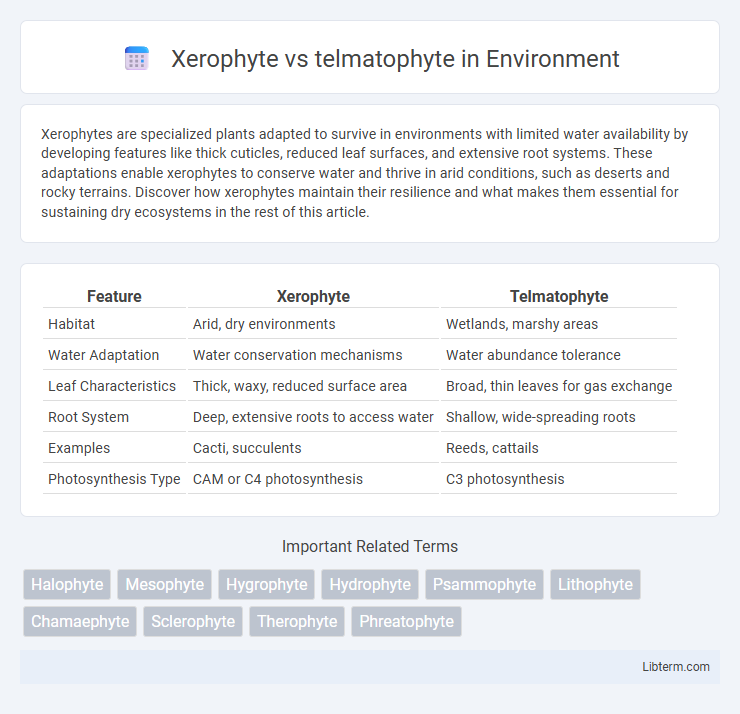Xerophytes are specialized plants adapted to survive in environments with limited water availability by developing features like thick cuticles, reduced leaf surfaces, and extensive root systems. These adaptations enable xerophytes to conserve water and thrive in arid conditions, such as deserts and rocky terrains. Discover how xerophytes maintain their resilience and what makes them essential for sustaining dry ecosystems in the rest of this article.
Table of Comparison
| Feature | Xerophyte | Telmatophyte |
|---|---|---|
| Habitat | Arid, dry environments | Wetlands, marshy areas |
| Water Adaptation | Water conservation mechanisms | Water abundance tolerance |
| Leaf Characteristics | Thick, waxy, reduced surface area | Broad, thin leaves for gas exchange |
| Root System | Deep, extensive roots to access water | Shallow, wide-spreading roots |
| Examples | Cacti, succulents | Reeds, cattails |
| Photosynthesis Type | CAM or C4 photosynthesis | C3 photosynthesis |
Introduction to Xerophytes and Telmatophytes
Xerophytes are plants adapted to survive in arid environments with minimal water availability, showcasing features like thick cuticles, reduced leaf surface area, and deep root systems to minimize water loss. Telmatophytes, on the other hand, thrive in water-saturated or marshy habitats, developing adaptations such as aerenchyma tissue for oxygen transport and specialized root structures to withstand waterlogged conditions. Understanding these distinct adaptations provides insight into plant survival strategies within extreme ecological niches.
Defining Xerophytes: Key Characteristics
Xerophytes exhibit specialized adaptations such as thick cuticles, reduced leaf surface area, and deep root systems to thrive in arid environments with minimal water availability. Their cellular structures often include sunken stomata and succulent tissues for efficient water storage and retention. In contrast, telmatophytes are adapted to wet or marshy habitats, exhibiting features like aerenchyma tissue for oxygen transport in waterlogged soils.
Telmatophytes Explained: Main Features
Telmatophytes are plants adapted to grow in marshy, swampy, or waterlogged environments, characterized by their ability to tolerate low oxygen levels in saturated soils. These hydrophytic plants possess specialized root systems with aerenchyma tissue that facilitates oxygen transport to submerged parts, ensuring respiration under anaerobic conditions. Unlike xerophytes that thrive in arid regions, telmatophytes exhibit morphological and physiological adaptations to survive in consistently wet or aquatic habitats.
Habitat Differences: Arid vs Wet Environments
Xerophytes are specialized plants adapted to thrive in arid environments with minimal water availability, often exhibiting features such as thick cuticles, reduced leaf surfaces, and deep root systems to conserve and efficiently use water. Telmatophytes, in contrast, are adapted to wet habitats such as marshes, swamps, and other waterlogged soils, possessing structures like aerenchyma for oxygen transport in saturated conditions. These habitat differences dictate their physiological and morphological adaptations, enabling xerophytes to withstand drought stress while telmatophytes cope with water saturation and low oxygen availability.
Morphological Adaptations: Xerophyte Strategies
Xerophytes exhibit specialized morphological adaptations such as thick cuticles, reduced leaf surface area, and sunken stomata to minimize water loss in arid environments. Their leaves often transform into spines or scales, reducing transpiration and deterring herbivory. Succulent tissues in xerophytes store water efficiently, enhancing survival during prolonged droughts.
Physiological Adaptations of Telmatophytes
Telmatophytes exhibit specialized physiological adaptations to thrive in waterlogged environments, including aerenchyma tissue that facilitates oxygen transport to submerged roots and the development of anaerobic respiration pathways to tolerate low oxygen conditions. These adaptations enable efficient gas exchange and metabolic function despite hypoxic soil conditions typical of wetlands. Furthermore, telmatophytes often have root structures adapted to fluctuating water levels, enhancing nutrient uptake and survival in saturated habitats.
Ecological Roles and Importance
Xerophytes play a critical ecological role in arid and semi-arid environments by conserving water and stabilizing soil, thus preventing desertification. Telmatophytes thrive in wetlands and marshes, contributing to water purification, nutrient cycling, and providing habitat for diverse aquatic species. Both plant types are vital for maintaining ecosystem balance by adapting to extreme moisture conditions and supporting biodiversity.
Examples of Xerophytes Around the World
Xerophytes, such as cacti in the Americas, agave in Mexico, and euphorbias in Africa, are plants adapted to extremely dry environments with features like thick cuticles and deep root systems. In contrast, telmatophytes, including species like reeds, cattails, and mangroves, thrive in waterlogged or marshy habitats with adaptations for submerged roots and oxygen-poor soils. These distinct ecological adaptations highlight the specialization of xerophytes for arid conditions worldwide, while telmatophytes are tailored for aquatic or semi-aquatic ecosystems.
Common Telmatophyte Species and Their Habitats
Common telmatophyte species such as Phragmites australis (common reed) and Typha latifolia (broadleaf cattail) thrive in wetland habitats including marshes, swamps, and riverbanks characterized by saturated soils and standing water. These plants have adaptations like aerenchyma tissue to facilitate oxygen transport in waterlogged environments, enabling them to dominate aquatic and semi-aquatic ecosystems. Their ecological role includes water filtration, providing habitat for wildlife, and stabilizing soil in wetlands.
Xerophyte vs Telmatophyte: Comparative Summary
Xerophytes thrive in arid environments with adaptations like thick cuticles, reduced leaf areas, and deep root systems to conserve water, while telmatophytes inhabit wetland or marshy areas, exhibiting features such as aerenchyma tissue for oxygen transport and shallow roots to cope with waterlogged soils. Xerophytes' physiological traits emphasize drought resistance, including CAM photosynthesis and stomatal regulation, whereas telmatophytes focus on anaerobic respiration tolerance and nutrient uptake in hypoxic conditions. Comparative studies highlight these distinct morphological and physiological strategies as key evolutionary responses to contrasting moisture availability in xeric versus hydric habitats.
Xerophyte Infographic

 libterm.com
libterm.com